The History of Grand Theft Auto
Learn about the history of this influential and controversial franchise in this special feature!
Design by Collin Oguro
See it in Action!
Our video depiction of the History of Grand Theft Auto takes a surprising and dramatic turn.
The Grand Theft Auto series has been celebrated by video game fans, demonized by politicians, and even studied by academia. More so than any other game franchise, the franchise elicits strong emotions from a wide range of people, even those not tied into the game industry in some way. Former presidential candidate Joe Lieberman has denounced the series repeatedly, calling it "horrendous." Meanwhile, respected professors, such as Henry Jenkins of the Massachusetts Institute of Technology, find redeeming value in the very same games, noting their open-ended nature and the way the games explore the "notion of choice and consequence." The combination of popularity and edgy content made Grand Theft Auto a lightning rod for the debate on violence in video games.
Thanks in part to publicity generated by the controversy over the content of the games, the Grand Theft Auto franchise is one of the most recognized video game brands on the market. All this attention isn't without merit, though. The newer iterations in the series are widely recognized as excellent games, garnering widespread critical acclaim and generating incredible sales. Grand Theft Auto III and Grand Theft Auto: Vice City have won numerous editorial awards and both have sold millions of copies over a range of different platforms. The newly released Grand Theft Auto: San Andreas has also rated highly with critics thus far and is poised to sell millions of units over the next several months. On the night of the game's release, gamers lined up outside the doors of retailers across the country so they could pick up their versions of San Andreas.
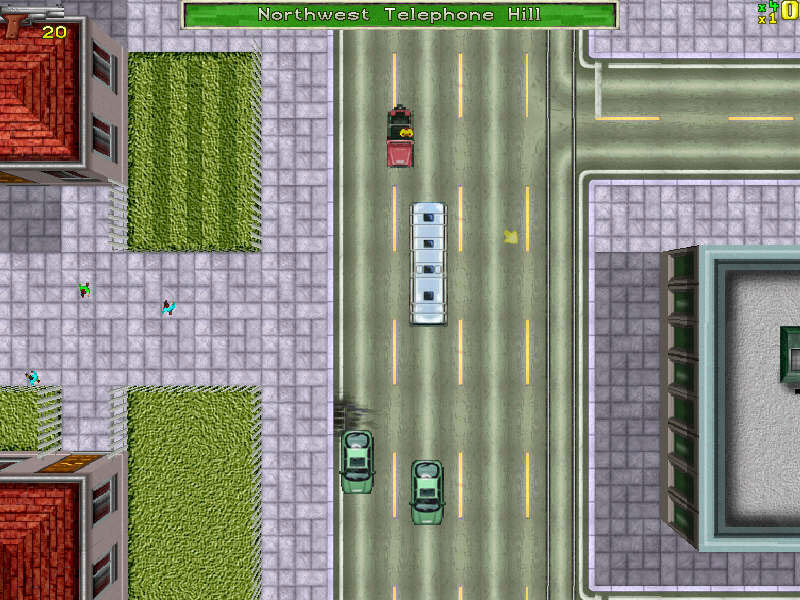
It's hard to believe that a game that has become an icon of the entire video game industry got its start from a primitive-looking and sounding 2D game. In fact, the original Grand Theft Auto didn't even rate highly with critics. It wasn't until the third game in the series that the franchise really took off and achieved pop icon status. GameSpot's History of Grand Theft Auto traces the story of this controversial franchise back to its roots to give you a perspective on where it has been and where it might be going.
For those who started the series with GTA III, seeing what the original game looked like may come as a surprise…
Humble Beginnings
Grand Theft Auto (PC, PS)
Released: 1998
Read The Review!
The original Grand Theft Auto was released on the PC in early 1998. Even for those days, the game's top-down, 2D graphics were relatively primitive. Your character and other people walking around the levels animated awkwardly. The bullets you fired from the guns were represented as fast-moving dots, much like a first-generation shooter on an 8-bit Nintendo. The dead would fall to the ground and bleed, but they resembled squashed insects more than deceased human beings. There was no speech in the game either. The characters you met and talked to spoke in a Sims-like gibberish that sounded like an audio tape or vinyl record being played back at high speed.

There were some nice details included in the game, though. A variety of different cars and trucks were included, each with their own speed and handling characteristics. Some of the faster sports cars could easily reach speeds four or five times faster than the slowest trucks, making control an adventure, to say the least. Backing up a large truck or bus resulted in a familiar beeping, which is an almost sarcastic detail to include, as the safety of nearby pedestrians was never a paramount concern. Different cars would also play different types of music on the radio by default. Jack someone's pickup truck and you'd hear country music.
The people who played and enjoyed the original Grand Theft Auto didn't play it for its production values, which were budget level. Instead, it was the game's irreverent style and open-ended gameplay design that made the game a cult hit among game players. Grand Theft Auto offered two different levels in each of the three large cities: Liberty City, Vice City, and San Andreas. Scattered throughout each city were special buildings, like spray shops, which would allow you to repaint your car in order to confuse police that might be tailing you. There were also loading cranes at the docks, where you could dump stolen cars for cash. As you started each level, your character was directed to a pay phone where you'd get the first in a series of criminal missions. The game was exceedingly difficult because you'd have to spend hours accumulating hundreds of thousands of points to advance to the next level. Since there was no save system, this required a ton of patience.
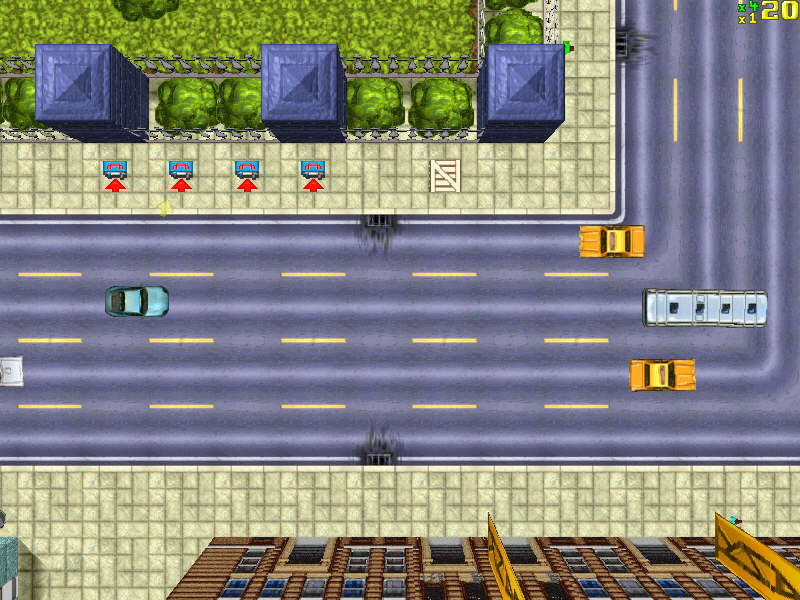
These missions would take you all over each city, and they varied from simple taxi-style jobs to assassinations to car-theft rings. There were getaway driving missions where you'd need to pick up mobsters escaping a bank heist, and even missions where you'd drive a bomb truck up to police stations to blow them up. You didn't have to participate in the pay phone missions, though. A big part of the fun was exploring each city and finding secret missions to do, or just causing general mayhem and eluding police while using weapons such as machine guns, rocket launchers, and flamethrowers. To aficionados of the original Grand Theft Auto, the funniest part of the game was finding a line of Hare Krishna-like chanters walking around clad in peach-colored robes. Running them all over in a line would result in a special chime and the exclamation, "Gouranga!" displayed onscreen.
Doomed to Stagnation?
Grand Theft Auto: London 1969 (PC, PS)
Released: 1999
Read The Review!
Grand Theft Auto eventually found its way onto the original Sony PlayStation, and an expansion pack called London 1969 was released. As the title suggests, Grand Theft Auto: London 1969 took the series into a different time period and setting. But as far as the gameplay went, not a lot changed, aside from driving on the left side of the road. The top-down graphics were the same, you still ran errands for big crime bosses in order to climb up the proverbial ladder, and you still couldn't save your game in the midst of a level.
Grand Theft Auto 2 (PC, PS, DC)
Released: 1999
Read The Review!

The sequel, Grand Theft Auto 2, at least made a token attempt at advancing the series. That game included a near-future setting with the addition of several rival gangs thrown into the mix. By completing missions for one gang, you increased your sway with them and unlocked additional missions, but at the same time, you would anger one or more of the other gangs and lose favor with them. Head into the territory of a hostile gang and you could expect to see shots fired your way. Your standing with each of the game's gangs was represented in the top left corner via a series of slider bars.
Later in the game, you were able to pay for weapon upgrades and other tweaks for your cars, including machine guns and oil slicks, respectively. The effect was not unlike playing Spy Hunter, but the fragility of the cars made weapon upgrades a dubious value in the game. Aside from these minor tweaks, everything pretty much remained the same between Grand Theft Auto and its sequel--the top-down, 2D presentation and the tedious manner in which you had to accumulate points to unlock later levels both remained.
Players would have to wait until Grand Theft Auto III for changes that revolutionized the franchise, and many would argue they were changes that revolutionized gaming in general…
A Vision Realized
Grand Theft Auto III (PC, PS2, XB)
Released: 2001
Read The Review!
The most obvious difference between Grand Theft Auto III and previous games in the series is the 3D engine, which was made possible by the series moving onto the PlayStation 2 console. Instead of having a detached and distant top-down view of the action, Grand Theft Auto III allowed you to explore a fully 3D world from a third-person perspective. This change brought you much closer to the action, giving the game a more personal feel. The people you were running over and shooting didn't look like squashed bugs anymore. You could actually see the main character inside of the cars, steering as you commanded.

The setting was restricted to just Liberty City, but from the new perspective, the town took on a whole new feel and it encouraged players to explore. Compared to the tiled, repetitive look of the cities in the previous two games, Liberty City in Grand Theft Auto III felt like an actual, organic place. There was an array of storefronts, funny signage to read, and unique buildings to visit, such as a stadium and a casino. The city was designed in such a way that those who played the game long enough could actually navigate by landmarks without using the map. The use of a day and night cycle also contributed to the atmosphere, and it gave the game a more lifelike feel. There was also licensed music and speech in the game. In fact, the developers used celebrity voice actors like Michael Madsen, Joe Pantoliano, and Kyle MacLachlan to lend a more professional air to the game's cutscenes.
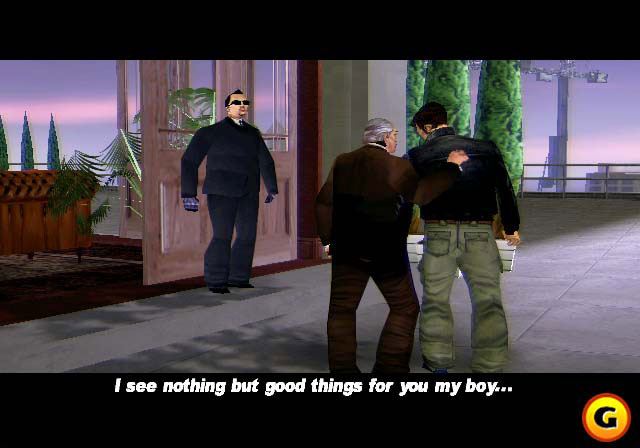
The dramatic difference in production values from the first Grand Theft Auto to the third was breathtaking. But the spirit of the actual game did not change. The open-ended gameplay design of the original games remained, allowing you to still explore a huge city, jack cars, shoot random people, and cause mayhem. Perhaps the biggest change in the gameplay department was the inclusion of a well-written, main storyline, influenced heavily by popular crime films like Goodfellas and Heat. The integration of an overarching plot into Grand Theft Auto III gave players a much better sense of purpose to each mission. Every time you delivered a package, knocked off an opposing crime boss, or tailed a snitch, you were helping your family get ahead in the mob wars.
For those not so interested in following the main story, there was still plenty to do in Grand Theft Auto III. Many found it fun just committing random crimes and earning higher and higher "wanted" ratings so the FBI helicopters and military tanks would go after them. You could also steal emergency vehicles like fire trucks and go on special missions with them. In a somewhat ironic twist, you could also steal a police car to go on vigilante missions to snuff out other criminals. The changes made to the series in Grand Theft Auto III took the game to a new level and spawned plenty of imitators in the video game market. But none of these really surpassed GTA 3 until the next game in the series: Vice City.
"I Ran So Far Away..."
Grand Theft Auto: Vice City (PC, PS2, XB)
Released: 2002
Read The Review!
Grand Theft Auto: Vice City didn't fundamentally change the franchise the way its predecessor did. Instead, the game piled on even more style and panache to a series that already reeked of both. Set in the 1980s, Vice City's signature feature is arguably its amazing soundtrack. Dozens of tracks from signature '80s musicians are included in the game, such as Michael Jackson, Herbie Hancock, and Frankie Goes to Hollywood. It was quite fun to try to ditch the police while having Flock of Seagulls' "I Ran" blaring on the radio. You could easily change radio stations inside of any car and enjoy not just the music, but also hilarious commentary from the DJs.
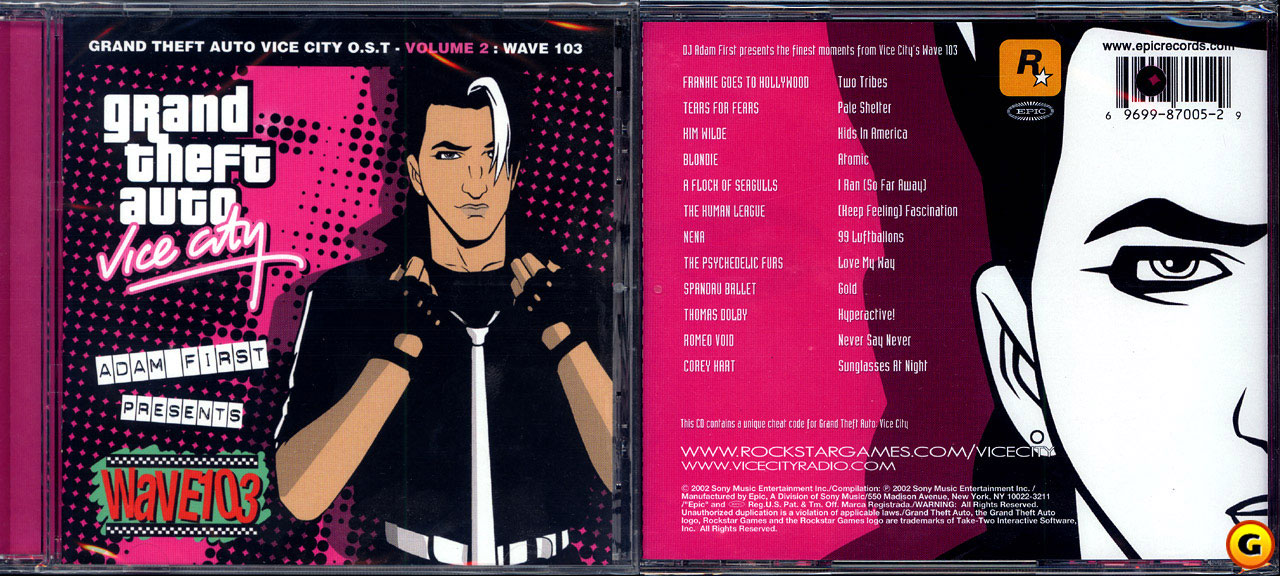
The game wasn't just about the music, of course. You still played the role of an up-and-comer in the criminal underworld. As Tommy Vercetti, you were looking to find out who double-crossed you on a busted drug deal. At the outset, the only man on your side is your smarmy lawyer, voiced to comic perfection by William Fichtner. An all-star cast of actors filled out the rest of the voice roles, including Ray Liotta as Vercetti, Tom Sizemore, Dennis Hopper, Danny Trejo, and Gary Busey. Even Philip Michael Thomas has a big part in the game, which was an apparent nod to the TV show Miami Vice, an obvious source of inspiration for the game.
As in Grand Theft Auto III, you'd search out missions from a variety of sources and do various criminal jobs. Eventually you would earn your own criminal empire and buy off different businesses in the city, such as the car dealership or the nightclub, which would earn money continuously. There were tons of little extras packed into the game, like dozens of hidden packages to find, cleverly placed ramps to test your motorcycle- and car-jumping skills, and more. Vice City also allowed you to explore the interiors of certain buildings, such as shopping malls, where you could rob the various stores.
The Miami-like setting allowed you to drive and steal not just cars, but also motorcycles, boats, and helicopters as well. The city was massive and included various venues, including a racetrack, a golf course, an airport, and even a large military base where the prize vehicle of the game, an attack helicopter, was stashed.
That the game drew from real-life Miami didn't go unnoticed, however. A number of months after the game was released, Haitian-American civil rights groups raised a public outcry over the inclusion of a mission whose prime directive was "Kill all the Haitians," as well as the depiction of Haitians in the game as gang members. This controversy, however, did little to stem the momentum of a franchise that had already been riding the wave of controversy for years. The outcry came off more as a Johnny-come-lately effort, with the original game drawing enough attention to get banned from a few countries and Grand Theft Auto III earning criticism from prominent American politicians.

Without greatly altering Grand Theft Auto III's winning formula, Vice City added more features and a truckload of style. The game eventually was released for the Microsoft Xbox console, along with Grand Theft Auto III in a retail package dubbed the Double Pack, which brought the franchise to an even wider audience than the PlayStation 2 and PC owners who had been enjoying the series for years.
Two years have passed now since Vice City's release, and Rockstar has just released the newest GTA game, San Andreas. Again, the setting and time period takes a turn, this time mimicking the gritty gang culture of 1990's Los Angeles. How would this game be received?
Dee Oh Double Gee!
Grand Theft Auto: San Andreas (PS2)
Released: 2004
Read The Review!
Unlike Liberty City and Vice City, which were deemed to be singular municipalities, the setting of the latest Grand Theft Auto, San Andreas, is considered an entire state, based roughly on California. The game actually includes three different cities. Players start the game off in the ghetto of Los Santos (Los Angeles) and eventually make their way into San Fiero (San Francisco), and Las Venturas. Each city in San Andreas includes easily recognizable landmarks inspired by the real-life cities on which they're based. You'll see monuments resembling the Watts Towers in Los Santos, major bridges in San Fiero, and lavish casinos lining the strip in Las Venturas.
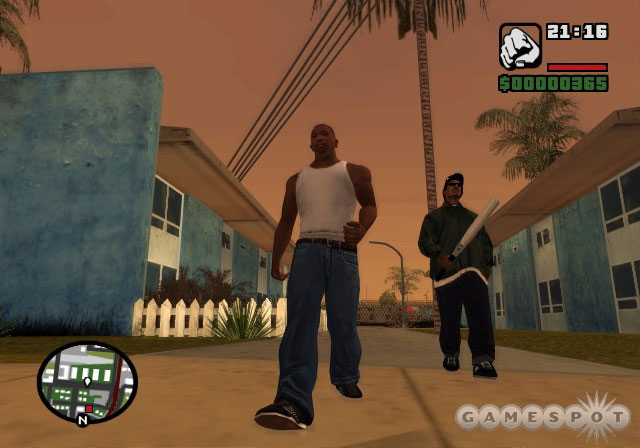
The time period is the early 1990s, so the game takes a lot of its plot cues from gangster movies of the same era, like Boyz 'N Da Hood and Menace 2 Society. You'll take the role of Carl "CJ" Johnson, a young man who had been living in Liberty City for five years to escape the gangbanging lifestyle he grew up with in Los Santos. The game starts off with CJ arriving back in Los Santos just after the mysterious death of his mother. Before long you're picked up by a corrupt Los Santos police officer (played brilliantly by Samuel L. Jackson) and blackmailed back into gang activity.
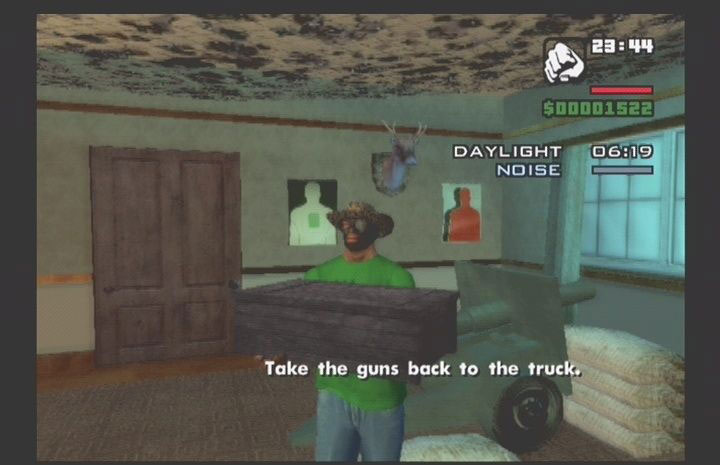
Eventually you'll build up the influence of your old gang, the Grove Street Families, back up to its previous level and beyond. Like the previous games, you'll do this by taking on missions from a variety of different people. These missions range from doing drive-bys on rival gangs to stealing weapons from local military bases to bouncing with the Latino gangs in a hydraulic-powered lowrider. The range of different things you get to do is even wider in San Andreas than it was in previous games.
As in Vice City, San Andreas features a star-studded, period-specific soundtrack. As you'd expect, the track lists are dominated by rap and R&B artists like Tupac Shakur, Dr. Dre, Snoop Dogg, Boyz II Men, and Bell Biv Devoe. A good array of classic rock, alternative, and country is also included to balance out the variety in the in-game radio stations. Another all-star cast of Hollywood actors fills out the voice roles in San Andreas. Joining Samuel L. Jackson are Ice-T, Peter Fonda, James Woods, to name a few.
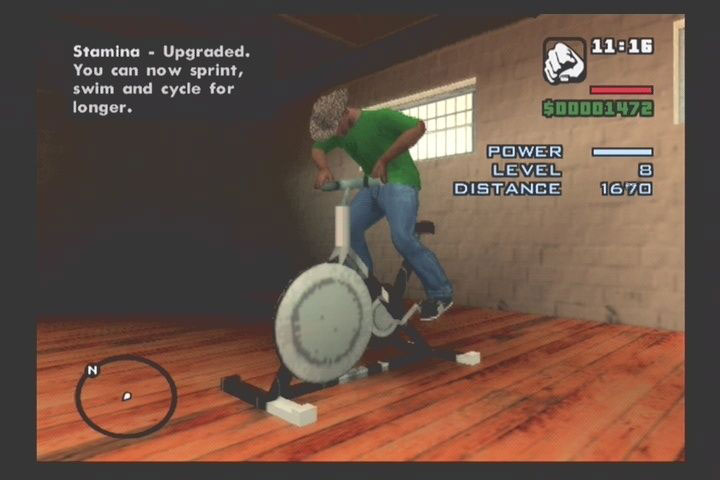
Some interesting role-playing elements were added to San Andreas. You can customize your character's strength, stamina, and other aspects by working out in a gym. You can have your character lift weights for strength boosts, ride an exercise bike to build stamina, and even spar to learn new fighting moves. Eating too much food will make your character visibly fat, and your skill at driving certain vehicles or using certain types of weapons will increase as you go through the game.
It remains to be seen how much controversy Grand Theft Auto: San Andreas will garner in the court of public opinion, but given the game's bold depictions of gang warfare and minority struggles in urban areas, it won't exactly be flying under the radar of social critics. The edgy content certainly doesn't appear to have negatively affected consumer interest though, with analysts forecasting millions of units in eventual sales for the game. The game has also been a smash hit with the critics as well, judging from the first batch of reviews. So, what's next?
The Grand Theft Auto series has certainly come a long way from its humble roots. Already some are speculating about the next big step for the series. A new graphics and game engine? That's a given. What about online play? Would it be massively multiplayer? Only the developers at Rockstar Games have an idea at this point as to where the series is heading, but given the satisfying evolution the series has undergone already, it's a safe bet that the creators won't be satisfied to rest on their laurels.
Got a news tip or want to contact us directly? Email news@gamespot.com
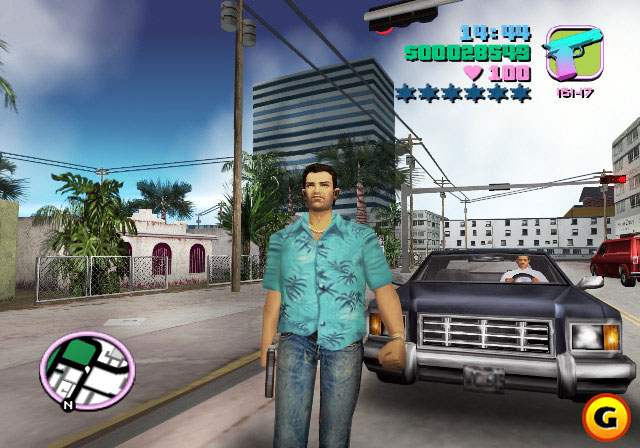
Join the conversation